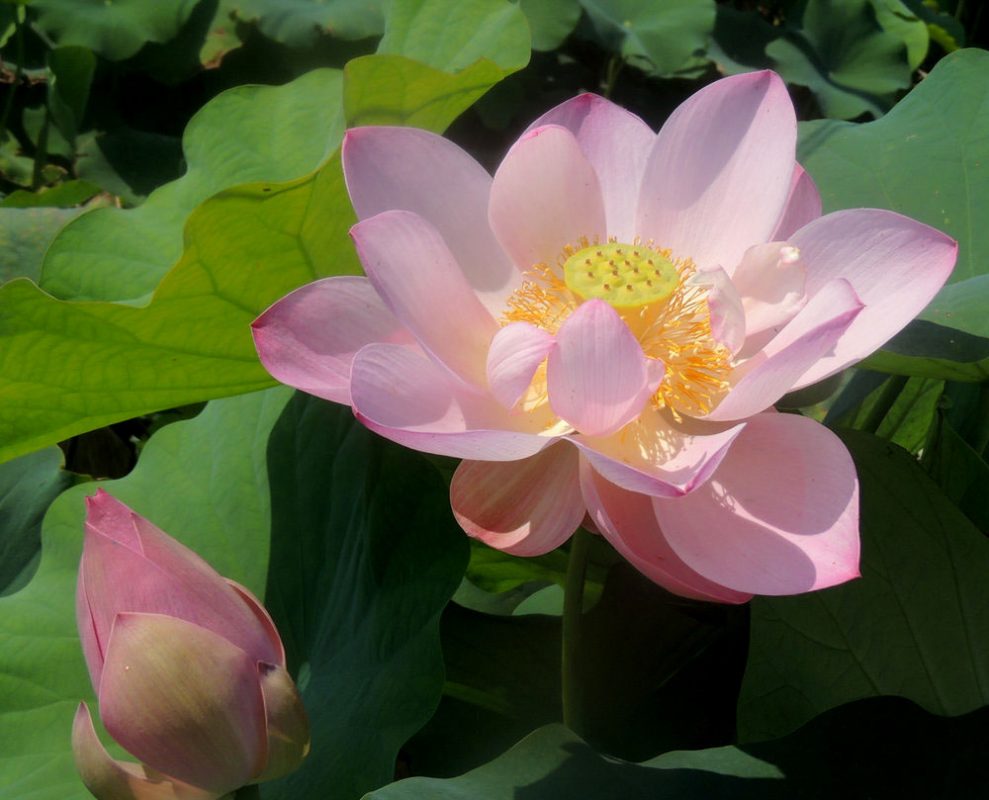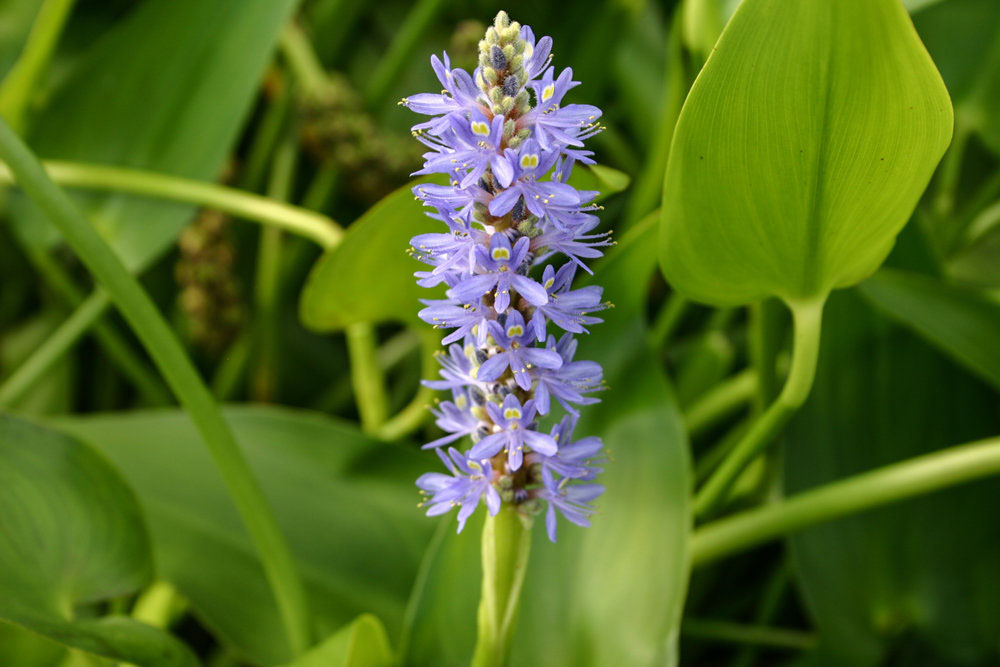11. Pond Plants: Types
For the avid water gardener, cultivating pond plants is an enduring pastime and a source of endless pleasure and satisfaction. Our aquatic nursery is teeming with hundreds of species of the most popular and successful varieties of hardy and tropical water garden plants. We’ve prepared an overview of our plant selections along with brief descriptions of how to plant and care for them. This will help you choose the right plantings for a beautiful and thriving water garden.

Hardy Water Lilies

This is the group of water garden show-offs that make water gardening so popular. Heart-shaped floating leaves are excellent for covering the water surface to provide shade and hiding places for goldfish and koi. Nodding just out of the water, graceful flowers, available in both single and double flowering varieties, range in color from white to deep red. These hardy plants are the staple in water gardens and overwinter to reappear in early spring. They even flower into the fall months.
The stem of the hardy water lily is actually a tuber which assumes a horizontal growth habit and gives rise to leaves and flowers. The petioles of the leaves adapt to a variety of water depths – up to 36” but most commonly 18-24” – bringing leaves to the surface to bask in the sun. The multi-petaled flowers open as the sun rises and close as evening approaches, lasting anywhere from two to four days each. Multiple flowers may appear at the same time. Most hardy water lilies do best with a minimum of 4 hours full sun, but will also perform fairly well in partial shade.
Feed monthly with Fertilizer Tablets. As winter approaches, simply remove all stems, leaves, and flowers and drop the pot to the deepest level in the pond and wait for spring. Repot when the plants become crowded or cease flowering.


Tropical Water Lilies

Named after their penchant for the tropics, tropical water lilies make a spectacular show for the water garden. Surrounded by large, mottled leaves, their brilliantly colored flowers are held distinctively above the surface of the water. Most are quite fragrant and flower more profusely than hardy lilies. With the exception of the southernmost regions of the United States, where they flourish year-round, tropical water lilies can be considered annuals in areas above Zone 8. Tropical lilies, however, can be preserved and planted again in the spring for many, many seasons.
Tropicals are loosely separated into day bloomers and night bloomers. Day bloomers generally open in late morning and close in the early evening. Their display of color ranges from orange to blue to purple and white create a beautiful display. Night bloomers begin to open in the evening and being to close mid-morning with blossoms of pink and white. Flowers usually last 3 to 4 days. The large leaves provide insulation from mid-afternoon heat, keeping water temperatures more comfortable for fish and other pond dwellers. The leaves also help in reducing light to nuisance algae.
This lovely group requires air temperatures of 80°F, a planting depth of at least 18”, and a minimum of 4 hours of sunlight per day. Feed monthly with Fertilizer Tablets. Tropical lilies require winter care in climates above Zone 8. See Tropical Lily Care for specific winterizing of your tropical lilies.

Lily-Like Aquatics

This group of aquatics encompasses a wide variety of species having a growth habit similar to the hardy lilies. Typically, leaves are floating and flowers are present above the water surface. A number of species produce lovely, fragrant flowers and their leaves are excellent surface cover and hiding places for fish. These plants can be either potted or allowed to roam but require occasional pruning to see that roots and stems do not clog intakes and filters. Available in both hardy and tropical varieties, these plants are nice additions to any water garden.

Lotus

Lotus are towering beauties and are the true exotics of the water garden. The round, cupped leaves sometimes reach diameters of 24”. The striking flowers are held high above the water on sturdy stems and can reach heights of six feet. Flowers and leaves alike follow the direction of the sun. The distinctively veined leaf repels water. Water droplets can often be seen dancing on the surface. Flowers, available in single and double flowering varieties, range in color from white, pink and yellow and are faintly fragrant. The Momo Batan Lotus is a favorite deep pink dwarf variety, only reaching an average height of 2 feet. The center of the lotus flower is often seen in dried arrangements, and other flower parts are used in Asian cooking.
Lotus, robust and hardy, is propagated in early spring and fall. Similar to the hardy lilies, the lotus stem is actually a fleshy tuber with an active growing tip. From the growing tip, flowers and leaves emerge. It is from these active segments of the tuber that new plant material is propagated. Separation is made between the segments, cutting slightly behind the indentation. The actively growing end is placed in a large pot with the growing tip angled upward. The new cuttings are held in place with heavy clay soil and gravel. Lastly, they are placed in a deep section of the pond.

Oxygenating Pond Plants

Oxygenating plants are named as such because they live submerged under the water surface and release their photosynthetic by-product, oxygen, into the water, keeping it richly supplied with this vital gas. In addition to oxygen production, this interesting group of plants plays an important role in the control of nuisance algae. They more effectively compete for nutrients. Most oxygenating plants display an abundance of leaves, though reduced in size, on long, flowing stems. The three most notable species for the garden pond are Elodea (Anacharis), Cabomba and Hornwort. As members of the flowering plant group “Angiosperms”, oxygenators produce flowers which may be visible or inconspicuous depending on the species.
Oxygenating plants are usually available in bunches. For every gallon of water, the pond should be stocked with 1 bunch, or 7-10 stems. They are potted or allowed to roam, but care must be taken to ensure that roots and stems do not clog intakes and filters. Occasional pruning and removal of dead and decaying plant material helps keep the plants vigorous and the pond crystal clear.

Floating Pond Plants

The most notable examples of floating plants are Water Hyacinth, Salvinia, Water Lettuce, Azolla, and Duckweed. Duckweed is the smallest member of the flowering plant family, though its flower is very inconspicuous. Water Hyacinth, a nuisance plant in more tropical regions of the United States, is a favorite with water gardeners above Zone 9. It has lovely foliage and showy cluster of purple flowers. The dangling root systems of Water Hyacinth and Water Lettuce also act as a filtering system, collecting debris from the pond and help keep the water clear and clean. Floating plants are excellent choices to add variety to the surface and provide shade and hiding places for fish.

Hardy and Tropical Shallow Water Pond Plants

Adapted to the shallow, damp margins of the pond, this plant group adds interest and variety to the pondscape. Many flowering and nonflowering hardy and tropical varieties are available in just about very conceivable height and growth form. They range in height from the low growing, creeping types that grow over the water surface, to the tall, stately iris and papyrus grasses that make a striking planted background at pond’s edge. You can purchase tropical species each season. They can also be overwintered in a frost-free area and reintroduced to the pond once daytime temperatures reach the mid-70’s. Many nurseries make no distinction between shallow water plants and moisture-loving perennials.



